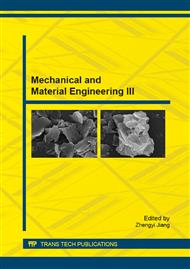[1]
Lisa M. Howe. (2015). Current Concepts in Negative Pressure Wound Therapy. Veterinary Clinics of North America: Small Animal Practice, In Press, Corrected Proof.
DOI: 10.1016/j.cvsm.2015.01.005
Google Scholar
[2]
Korakot Ngarnwongpanit, Sriwiwan Ongchai. (2004). The diagnosis of osteoarthritis in dogs using biological markers.
Google Scholar
[3]
Walter C. Renberg, James K. Roush. Veterinary Clinics of North America: Small Animal Practice. Lameness Vol 31 No. 1 (2001).
DOI: 10.1016/s0195-5616(01)50051-0
Google Scholar
[4]
McHarg, M., Baldock, C., Headey, B., Robinson, A. 1995. National People and Pets Survey. Urban Animal Management Coalition, Sydney, Australia.
Google Scholar
[5]
DeMello, L.R., 1999. The effect of the presence of a companionanimal on physiological changes following the termination of cognitive stressors. Psychology and Health 14, 859-868.
DOI: 10.1080/08870449908407352
Google Scholar
[6]
K. Altunatmaz, R. Yucel, Y. Devecioglu, M. Saroglu, S. Ozsoy. 2003. Treatment of canine hip dysplasia using triple pelvicosteotomy . Surgery Department, Faculty of Veterinary Medicine, Istanbul University, Avcilar, Istanbul, Turkey. Vet. Med. – Czech, 48, 2003 (1–2): 41–46.
DOI: 10.17221/5748-vetmed
Google Scholar
[7]
Korakot (2005). Comparative Study Chondroitin sulfate type WF6 and 3B3 in serum dogs with and without lesions hip dysplasia. 56 years Sattawaphaet Volume 3 December (2005).
Google Scholar
[8]
Fujiki M., K. Misumi and H. Sakamoto. 2004. Laxity of canine hip joint in two positions with computed tomography. J Vet Med Sci. 66(8): 1003-1006.
DOI: 10.1292/jvms.66.1003
Google Scholar
[9]
Chalman JA. and H.C. Butler. 1984. Coxofemoral joint laxity and the ortolani sign. J Am Anim Hosp Assoc. 21: 671-676.
Google Scholar
[10]
Tsai K.L. and K.E. Murphy. 2006. Clinical and genetic assessments of hip joint in the Boykin spaniel. Can J Vet Res. 70: 148-150.
Google Scholar
[11]
Harris, Eleanor L. Pet loss: a spiritual guide. St. Paul, MN: Llewellyn Publications, (1997).
Google Scholar
[12]
Belk RW. Metaphoric relationships with pets. Soc Anim Sci Stud Hum Exp Anim 1996; 4(2): 121–45.
Google Scholar
[13]
Denzin NK. 2003. The reflexive interview and a performative social science. Qual Res; 3(2): 243–68.
Google Scholar
[14]
Albert, A., Bulcroft, K., 1988. Pets, families, and the life course. Journal of Marriage and the Family 50, 543-552.
DOI: 10.2307/352019
Google Scholar
[15]
Beck, A.M., Meyers, N.M., 1996. Health enhancement and companion animal ownership. Annual Reviews Public Health17, 247–257.
DOI: 10.1146/annurev.pu.17.050196.001335
Google Scholar
[16]
Deborah L. Wells, Peter G. Hepper. 1999. Male and female dogs respond differently to men and women Applied Animal Behaviour Science 61: 341-349.
DOI: 10.1016/s0168-1591(98)00202-0
Google Scholar
[17]
Allen K., Shykoff B. E., Izzo J. L. (2001). Pet ownership, but not ace inhibitor therapy, blunts home blood pressure responses to mental stress. Hypertension 38, 319–324.
DOI: 10.1161/hyp.38.4.815
Google Scholar
[18]
Katcher, A.H., 1982. Are companion animals good for your health? Aging 331-332, 2-8.
Google Scholar
[19]
Garrity, T.F., Stallones, L., Marx, M.B., Johnson, T.P., 1989. Pet ownership and attachment as supportive factors in the health of the elderly. Anthrozoos 3, 35–44.
DOI: 10.2752/089279390787057829
Google Scholar
[20]
Lisa Corti, DVM, DACVS, CCRP, 2014. Massage Therapy for Dogs and Cats. Companion Animal Medicine. Volume 29, Issue 2, Pages 54–57.
DOI: 10.1053/j.tcam.2014.02.001
Google Scholar


